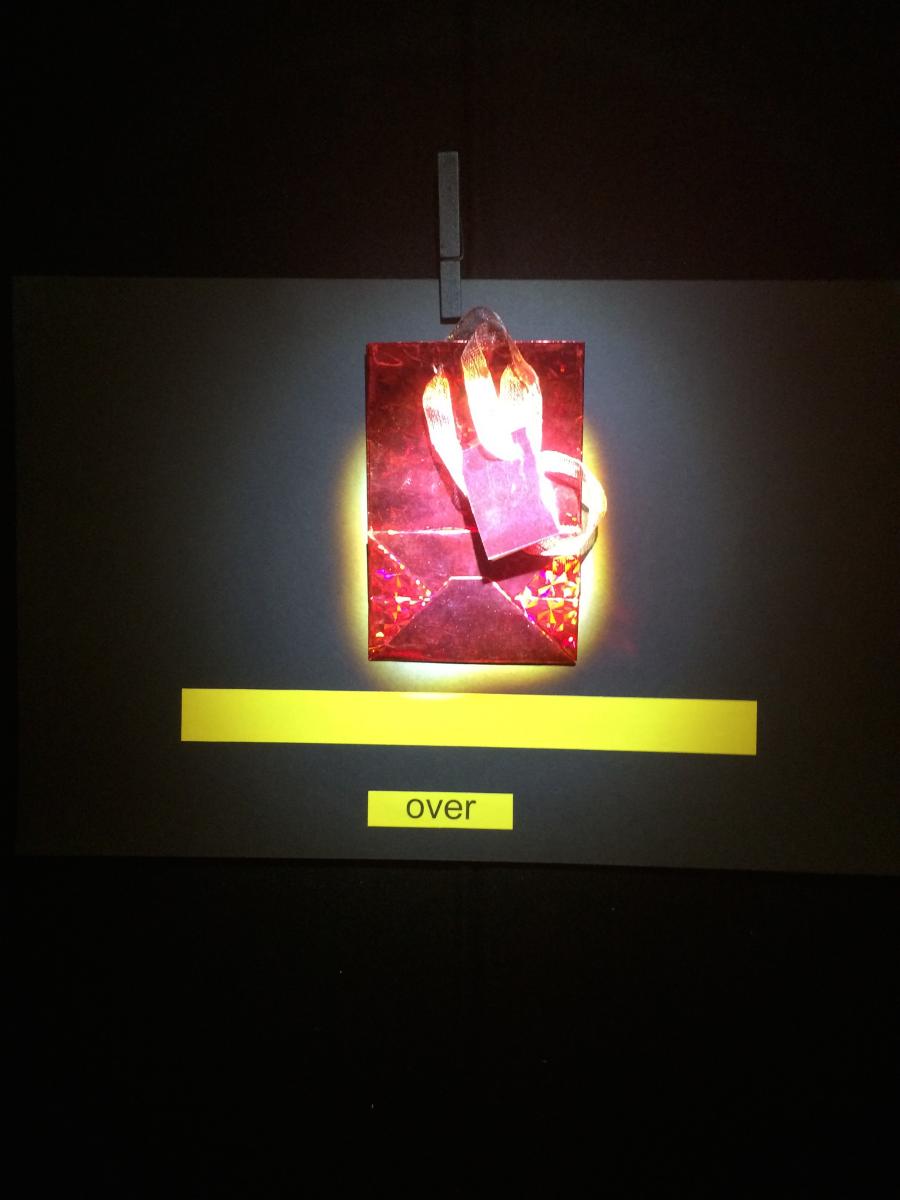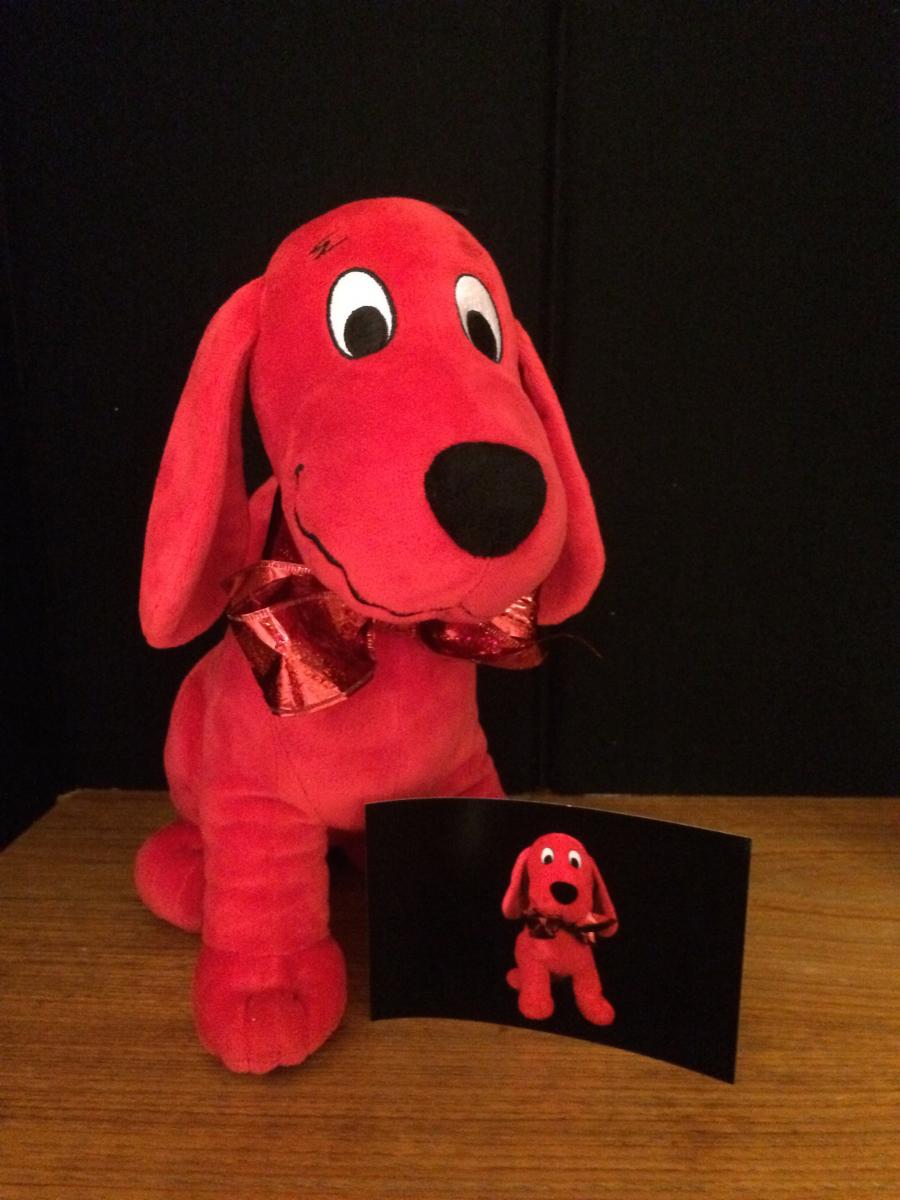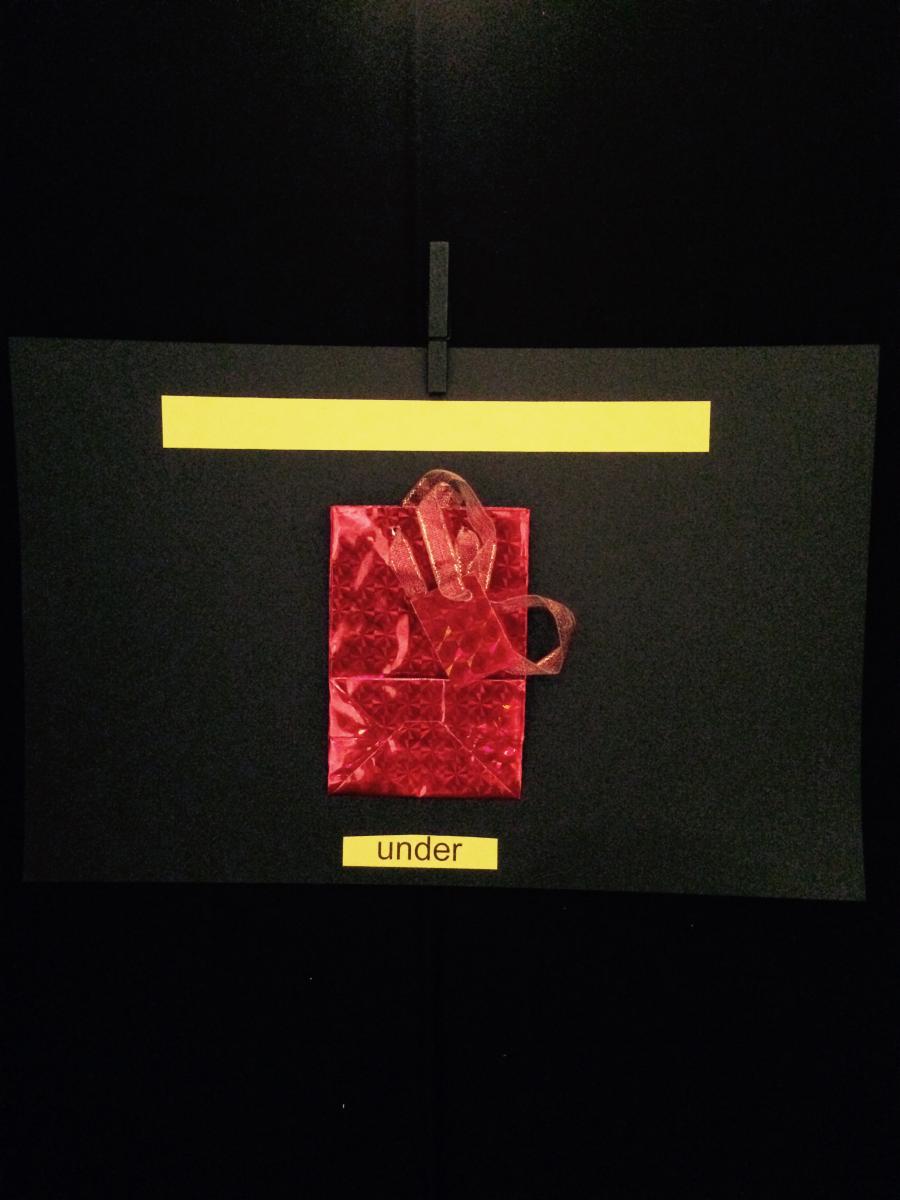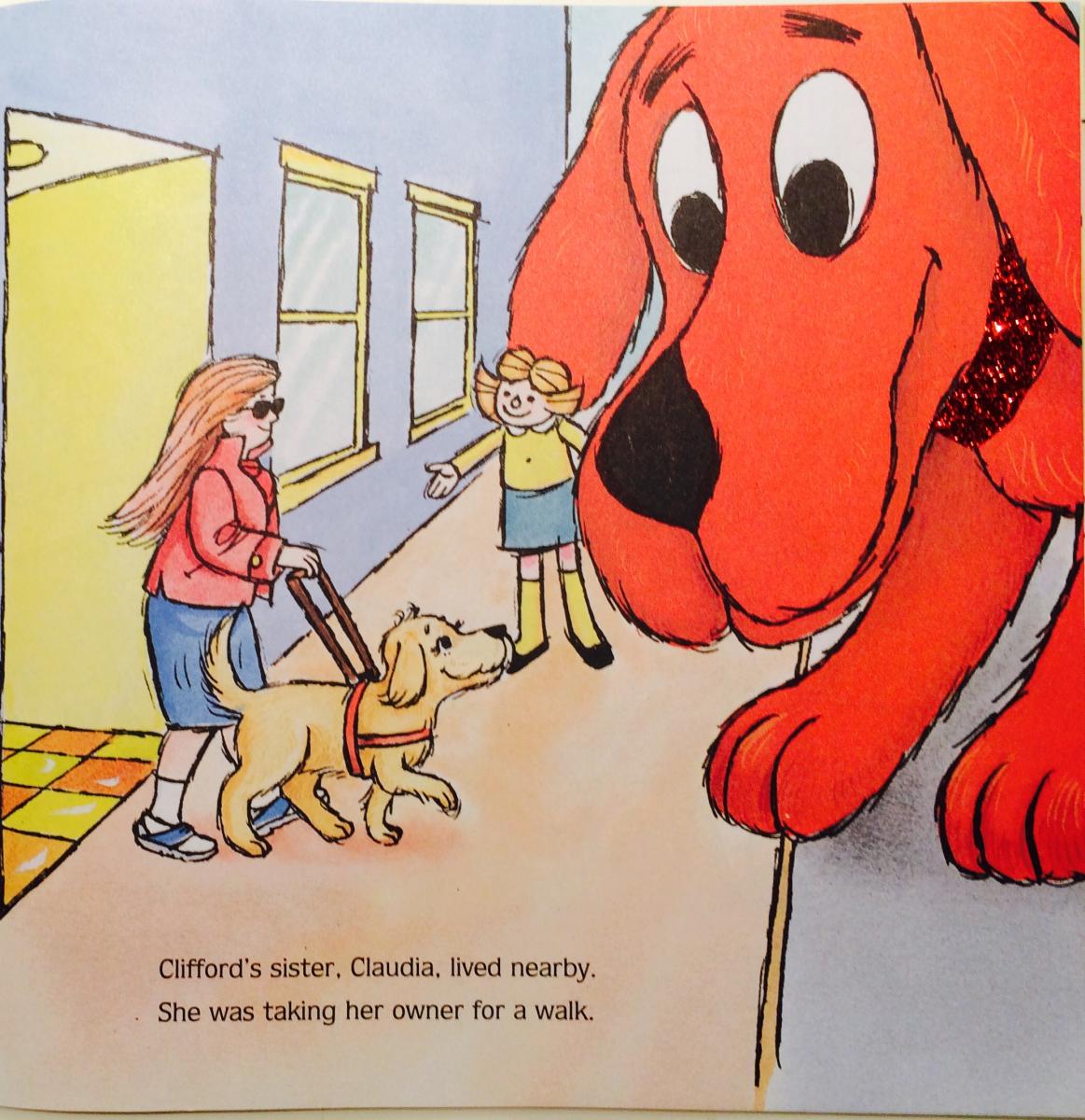By Diane Sheline, TVI, CLVT
Please begin by reading Literacy for Children with CVI: Overview and Implications for Different Phases.
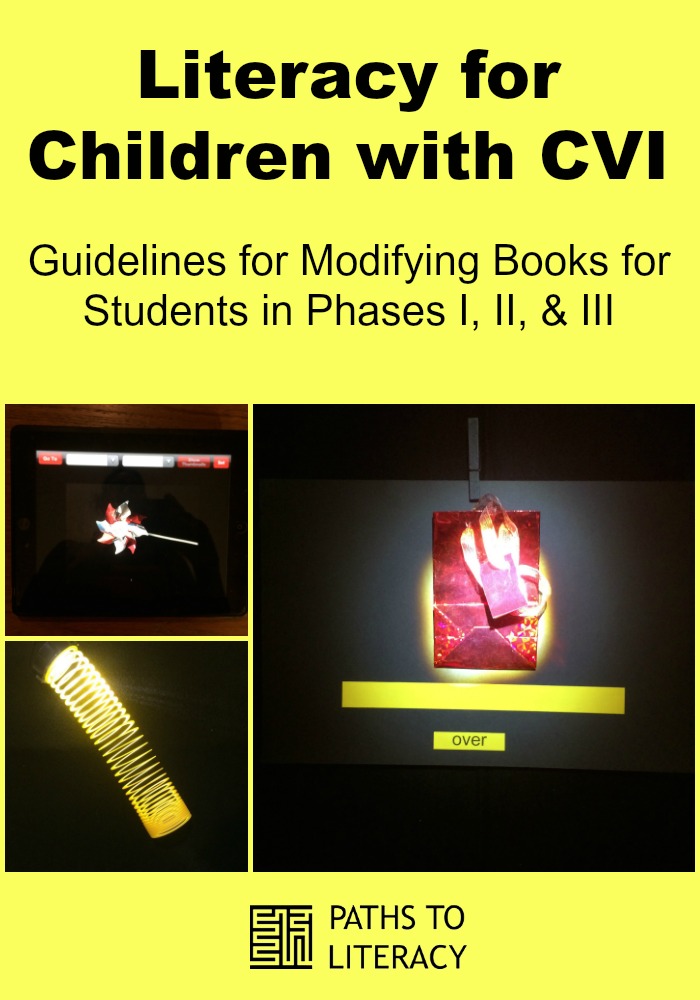 The following are guidelines that have been helpful to me when creating or modifying books for students who visually function in Phase I, Phase II and Phase III. The divisions are approximations only; there will be overlap. For example, I may discuss book considerations for students in Phase II, but they may also be appropriate for some students who are visually functioning at a high Phase I, etc. As noted elsewhere, you will need to take into consideration the student’s interests, information obtained through records review and Parent/Caretaker Interviews, informal and formal observations as well as information obtained from formal assessments, including (but not limited to) the Functional Vision Evaluation, Learning Media Assessment, Expanded Core Curriculum and finally, most importantly, the CVI Range.
The following are guidelines that have been helpful to me when creating or modifying books for students who visually function in Phase I, Phase II and Phase III. The divisions are approximations only; there will be overlap. For example, I may discuss book considerations for students in Phase II, but they may also be appropriate for some students who are visually functioning at a high Phase I, etc. As noted elsewhere, you will need to take into consideration the student’s interests, information obtained through records review and Parent/Caretaker Interviews, informal and formal observations as well as information obtained from formal assessments, including (but not limited to) the Functional Vision Evaluation, Learning Media Assessment, Expanded Core Curriculum and finally, most importantly, the CVI Range.
Literacy strategies for children who visually function in Phase I
If your child or student is just beginning to use vision and is visually functioning in Phase I on the CVI Range, the questions you should consider, prior to purchasing or making a book, might include the following;
- What, if any, is this child’s preferred color?
- Does this child need movement qualities (or reflective qualities) in a target to visually attend? Are movement qualities a distractor and rather than help, do they hinder the child?
- Does this child have a favorite, or familiar target he/she will look at above all else?
- Does this child experience latency?
- Does this child have a preferred visual field? Does this child visually attend to targets in his/her lower visual field? Are you able to present books and materials flat on the table in front of this child, near their tummy?
- How far away can materials be presented from their face?
- Will this child look at targets of more than one color or with a simple pattern?
- Can this child tolerate looking at more than one target in an array?
- Does use of backlighting or SpotLIGHTing help or hinder this student?
Once these questions are addressed, you can begin to create a book (or modify an existing book) and determine the best presentation of that book.
-
Choose a familiar, preferred target
 The most important quality I have found to entice children to use looking behavior with literacy materials is for the target to be familiar (a target the child has looked at again and again and/or highly motivating). The parent should be included in this discussion and is often the best person to ask for this information. Make sure to match the favored target carefully. If the child is familiar with and loves looking at the slow bounce of a bright yellow Slinky Jr., purchasing and developing a book using a dollar store “Spring” that looks like a Slinky, in a sparkly (possibly alternate) color, may not work! It is very important, especially for the child who is just beginning to use vision, for the target used in the book to be the same as the child’s preferred target from home.
The most important quality I have found to entice children to use looking behavior with literacy materials is for the target to be familiar (a target the child has looked at again and again and/or highly motivating). The parent should be included in this discussion and is often the best person to ask for this information. Make sure to match the favored target carefully. If the child is familiar with and loves looking at the slow bounce of a bright yellow Slinky Jr., purchasing and developing a book using a dollar store “Spring” that looks like a Slinky, in a sparkly (possibly alternate) color, may not work! It is very important, especially for the child who is just beginning to use vision, for the target used in the book to be the same as the child’s preferred target from home.
-
Limit to one target per page in Phase 1.
For many children who visually function in Phase I, there will need to be only one target per page and no page should be used on the back side. Books are best for this group of students when they are very simple. It is helpful to have the background (or page itself) be of a solid, contrasting color from the target, to help make the target stand out or, “Pop”. The target often needs to be in a solid, bright color, in the student’s preferred, most looked at color.
-
Include movement/reflective qualities.
Often, it is helpful for the target to have some sort of movement quality or be reflective (such as with mylar). For example, attaching a piece of a bright yellow Slinky directly to a page can create a small amount of movement, especially if the book is upright on a reading stand. For photos of what this strategy might look like, see the modified book, “One Yellow Slinky Bouncing Up and Down”.

-
Read for short periods, multiple times each day.
Keep reading time short, at first, but do it many times per day. It will be important to remember that at this stage, children need to use vision again and again for neural pathways to be strengthened. Vision is strengthened by repeating visual experiences again and again. As vision use improves, experiences that offer a slight change in the display, is helpful. It is a “use it or lose it” system, so making two books, one for home and one for school, would be a good idea!
-
Present materials in preferred field of view.
It will be important to always present literacy materials in the student’s best field of view. For students who visually function in Phase I, this may be at eye height towards the right or at eye height towards the left. Use of an All-In-One Board is often helpful to position materials correctly. Teachers and parents will need to look carefully at all assessment results to determine if the student has difficulty accessing visual targets in their lower visual field. Use of a slant board, reading stand, Invisiboard or All-in-One Board all can help to raise materials up to approximately eye height. Avoid placing materials flat on the student’s tray or table until you are certain the student can visually access them there.
-
Present materials at near.
Just as placement of literacy materials in the student’s best field of view is important, so is the distance that the materials are presented. Most students who visually function in Phase I have difficulty viewing materials that are further than arm’s reach away. Again, use assessment results to guide you in the distance the materials should be presented. In addition, make sure that the entire early intervention team is aware of the need to bring targets close to the student. Because of visual complexity in an array and visual complexity in the surrounding environment, students who visually function in Phase I need targets to be close. Viewing targets at near reduces the competing visual sensory input. That is why it is often helpful to use solid black pages and/or a black background (i.e. a black reading stand) as well as a black Invisiboard behind the literacy materials you are presenting. Both strategies help to reduce or eliminate the competing visual sensory input.
-
Allow time for processing.
Allow time for the student to process what he/she is seeing before turning to the next page. Allow time for latency. Watch for signs of visual fatigue including (but not limited to): closing eyes, turning away from the target, yawning and light-gazing.
-
Use SpotLIGHTing Techniques to illuminate an object or target on a page.
Use SpotLIGHTing Techniques to illuminate an object or target on a page (see strategytosee.com for information on SpotLIGHTing Techniques). Use of light on a target often draws the student’s visual attention to the target. Use a high-powered flashlight with at least 300 lumens or more. Direct the light at the target, without creating glare or shining the light in the student’s face. You may need to shine the flashlight from behind the student so that the student does not search for the source of the light and then light-gaze. I often use SpotLIGHTing Techniques to “jump start” use of vision in children who visually function in Phase I. I find that if I can get students to start using vision, they will more consistently use their vision for that session.
Literacy strategies for children who visually function in Phase II
Children who visually function in Phase II, are generally using their vision for functional purposes. Many of the above suggestions may still apply for your student or child, but before purchasing or making a book, additional questions you should consider might include the following;
- Does this child still have a preferred color? Does that color act as a visual “anchor” (C. Roman-Lantzy) which helps to draw the student’s visual attention?
- Is this child able to tolerate two or even three targets on a page? What about adding print to a page?
- Would this child benefit from use of Blocking Techniques or a Window Card/Occluder?
- Does this child understand 2D representations, such as a color photograph or realistic color illustration?
- Does back lighting help or hinder when 2D representations are presented on an iPad?
- Is this child able to use a visually guided reach to interact with the target(s) in the book and/or turn the pages?
- Does this child still benefit from placement of materials in a specific visual field? Is this child able to visually access materials when they are flat on the table or tray in front of them?
- At what distance is this child able to visually access literacy materials? How large does the print/target need to be at this distance?
-
Avoid abstract or complex illustrations.
It has been my experience that use of abstract color illustrations, realistic black and white line drawings, abstract black and white line drawings and Picture Communication Symbols (PCS), such as Mayer-Johnson, are especially difficult for students with CVI (this finding has also been supported in limited, informal sample studies by other TVIs). Students may alert to or visually attend to a bright color found as part of an image, but often do not understand what the image represents. In addition, the complexity created due to the multiple colors or lines found on most images, causes many children to look away and “tune it out”.
-
Start with color photograph of student’s favorite familiar target in the transition from 3D to 2D.
I often have the most success with the transitional process of moving from a 3D target to a 2D image if I start with a color photograph of my student’s favorite, familiar target(s). I try hard to make sure the image is very sharp and the target is photographed against a black background, to make the image of the target really stand out. I print 5” X 7” photographs in a matte finish, which produces less glare. I then mount the photographs, one to a page, using heavy, black card stock for the pages. For an example of this strategy, see the modified book, “My Favorite Things”.

-
Present familiar, color photo of child’s favorite object in electronic format on an iPad.
Presenting the familiar, color photograph of the child’s favorite object, in electronic format on an iPad where it is backlit, has also proven successful for this population. Programs and applications I have used include Keynote, Pictello and My Talking Picture Board (Little Bear Sees). Initially, present only one photograph at a time and if the student touches the screen, give them the real object. Later, as use of vision improves, two or three individual images might be presented using an application like, My Talking Picture Board.

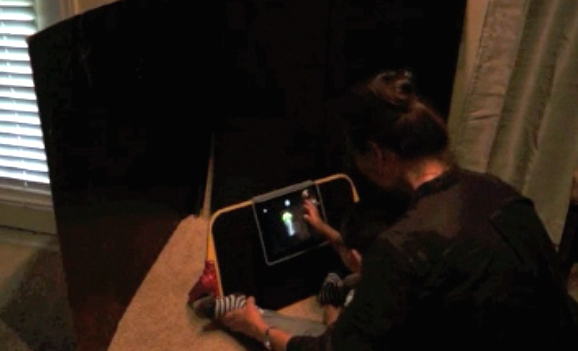
In the video clip below, a mother has her child’s favorite ball (an Oball) presented as a photo on her iPad, which is in her son’s field of view. Her son sees the image, crawls to the iPad and reaches out to grab the ball. The perceptive mother quickly gives him his real, 3D Oball and says, “Ball. That’s the ball. Here you go”. This begins the process for this child learning about 2D images.
-
Try adding one word to a page.
For some students who visually function in Phase II, one word of print may be added to a page (occasionally a few words). If the print proves to be too visually busy, you can use Blocking Techniques or a Window Marker to “hide” the print. When a word is presented or used on a page, remember to discuss the salient features of the shape of the word in addition to how that word relates to the visual target or picture on the page (i.e. encourage use of context clues).
-
Use Page Fluffers to help the child to turn the pages.
Students who visually function in Phase II may be helping with turning the pages of a book. It is often helpful to separate the pages by using “bumpers” or “Page Fluffers” between each page. These spacers separate the pages and encourage easy turning. See Materials Used for Adapting Books and Literacy for Students with CVI for more information on Page Fluffers.

-
Use SpotLIGHTing Techniques to illuminate an object or target on a page.
As with students who visually function in Phase I, use of SpotLIGHTing Techniques may still prove beneficial to a student who visually functions in Phase II. When using a teacher-made book or a commercial book, use of a high-powered flashlight (300 lumens or greater) behind the page and flush with the page also works well to outline or highlight a specific picture or word.
-
Reinforce relationship between 2D and 3D items for students working on Eye Gaze.
For students who have a good understanding of 2D representations and are working on Eye Gaze as a form of communication, I often take off the book binding (Pro-Click Spine) and present two pages that are widely spaced, each with a photo of a familiar target (for example, a favorite cup and a favorite toy). I hang the pages on an Invisiboard (or other slant board); one at far left and one at far right. When the child looks at one of the targets, I promptly give the student the real, 3D item that is associated with that picture and say a few descriptive words about that target, such as, “I see you were looking at the picture of the cup. It is yellow and has two hand holds.”
-
Spray paint wooden clothespins black.
Strategy idea: You can spray paint wooden clothespins black and attach black Velcro on one side of the clothespin. This is an excellent way to clip individual book pages to the Invisiboard, as the fabric on the Invisiboard is Velcro compatible and holds the black clothespin in place.
Literacy strategies for children who visually function in Phase III
Students who visually function in Phase III are working on resolving Behavioral Characteristics, but still may benefit from many of the suggestions noted above. Additional questions you should consider, prior to purchasing or making a book, might include the following;
-
What type of picture is this child able to accurately identify?
- Color photos of real, familiar targets?
- Color photos of real, unfamiliar targets?
- Realistic color illustrations?
- Abstract color illustrations?
- Realistic black and white line drawings?
- Abstract black and white line drawings?
- Picture Communication Symbols, such as Mayer-Johnson?
- If the child can accurately identify pictures, what size does it need to be and how much complexity within the picture can be tolerated?
- Is this child able to tolerate print (in addition to pictures) on a page? If so, how much print (one word, an entire sentence, etc.)? What font works best for this child and in what size?
- Can this child both look at the picture/print and listen to a story being told? What about a story being presented in musical, sing-song form?
- Can this child participate in the choice of subject matter for the book?
-
Use simple and bold font.
Students who visually function in Phase III are often able to tolerate several targets on a page, including print. When words are added to pages, make sure the font is simple and bold. The two fonts I prefer to use most often are Arial and Century Gothic (Bold). In addition, make sure the font size is appropriate. I find that 24pt. font often works well, but use what is noted in the recommendations from the most current Functional Vision Evaluation for your student or child.
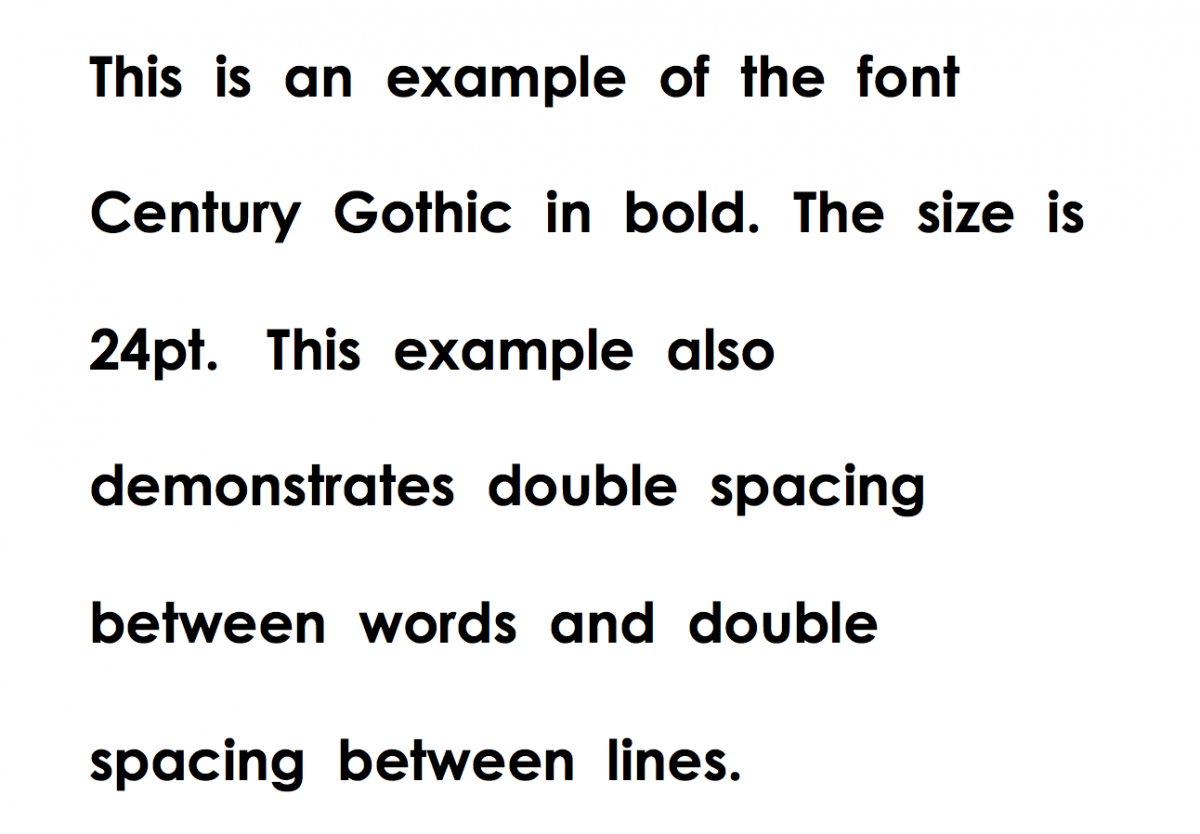
-
Double space to decrease visual clutter.
When many words or sentences are used per page, you may find that double spacing between words and using double line spacing between sentences also helps to create less “visual clutter”. This is demonstrated in the image above.
-
Start off with just one word on a page.
Rather than telling a story, you might consider creating a simple book with just one word on a page that names the target. For example, if the picture is of a favorite, familiar Oball, you might simply add the word, “Oball” below the picture (photo 1 below). If you choose to point out the shape of the word and discuss the salient features of that shape, you could color highlight the shape in the student’s preferred color (photo 2 below). Remember to point out that the picture on the page relates to the word, demonstrating how you can use context clues to help decipher the word.
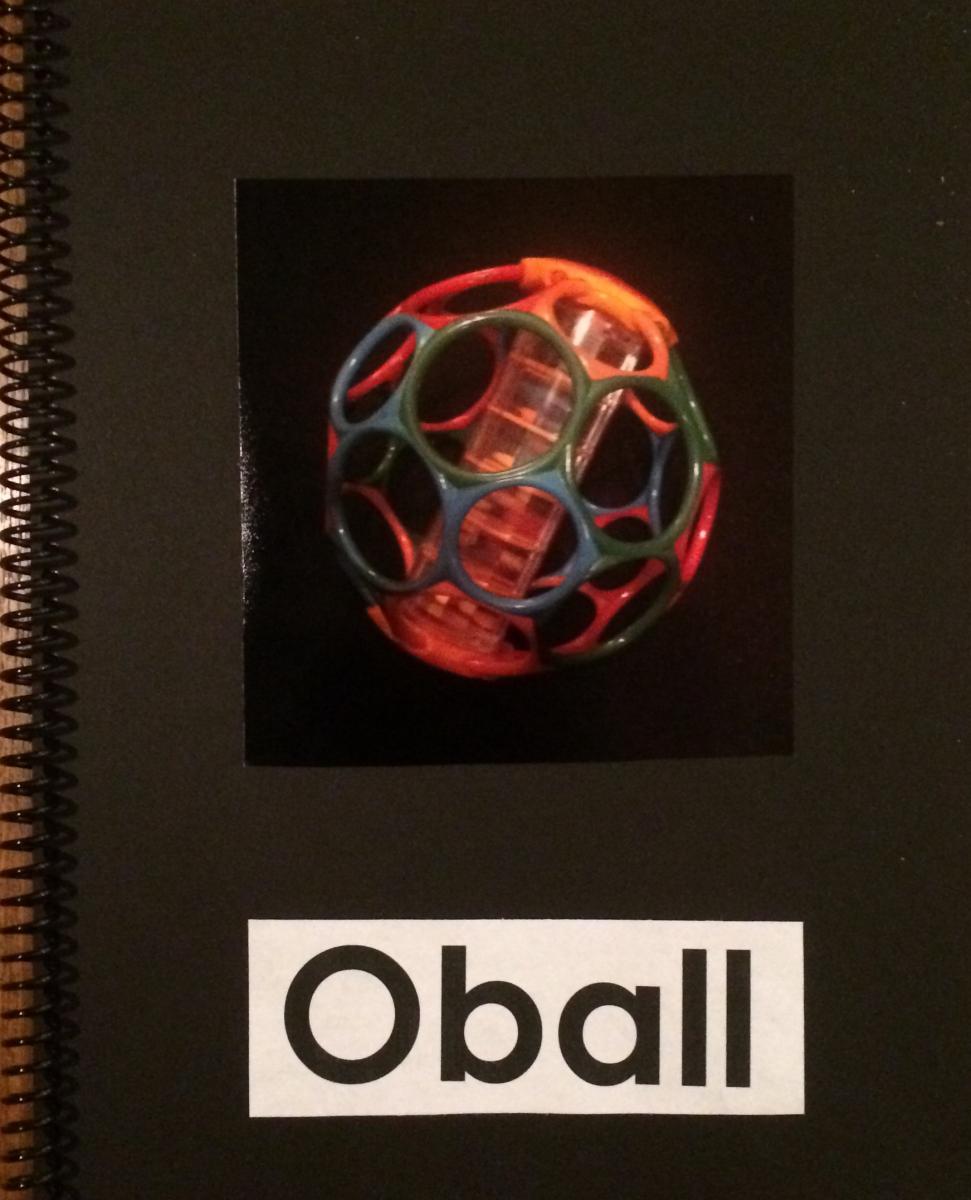

In addition to pointing out the salient features of the word shape, remember to describe the target in terms of its salient features as well. For example, for the Oball you might say, “This ball is round and made up of small round rings. The rings are orange, red, green and blue. There is a cylinder that runs down the middle of the ball which has small beads in it.” Remember to implement these ideas when creating books on your Tablet or iPad using iBooks, PowerPoint, Pictello or Book Creator as well.
-
Create a visual “anchor” using strong, highly visible color.
Students with CVI often benefit from a highly visible color to draw their visual attention to a specific shape, object or word. Dr. C. Roman-Lantzy has noted that often, “Color serves as a type of visual ‘anchor’ and can be used to highlight the salient features of a target”. This can also be called “color highlighting”, depending upon how it is applied. Draw visual attention to shapes, objects or words by using bold colored duct tape, brightly colored highlighters or a Sharpie marker (each in the student’s preferred color). For example, if you want to draw attention to a specific target repeated throughout a book, you might carefully place a strip of glittery, bright red tape on the target, being consistent in the placement of this “anchor” on the target throughout the book.
-
Use 2D images to create books on an iPad.
Students who visually function in Phase III are often able to look at pictures, such as realistic color illustrations as well as realistic black and white drawings, and understand that they represent a 3D object. As noted above, I usually begin this transitional process by introducing a 2D representation as a sharp, color photograph of the student’s favorite, familiar objects or toys. As the students get better at using their vision, more difficult 2D representations are worked on. I often create my own books on my iPad, using Book Creator and Pictello, along with downloaded images using Google Images. Google Image Search helps you locate specific pictures on the Internet for creating your own books (or you can download your own photos). For example, if you are working on the Word Family “at” and want to have pictures representing “at” words, you might search for pictures such as Elmo with a Cat (Elmo’s Cat), Elmo with a Hat (Elmo’s Hat), and Elmo with a Bat (Elmo’s Bat), using Google Images. * Please note that many of the images on Google Images are copyright protected and should not be used to create any books that will be shared broadly. There are a number of sites that have open access to copyright-free images, which should be used if you plan to distribute a book or make multiple copies.
-
Let the child choose the topic of the book.
When possible, let the student help to choose the topic of the book. The best way to motivate students to read and use books is to create or modify books that your student is highly interested in.
-
Create CVI-Friendly books with classroom themes.
Try to create “CVI-Friendly” books in conjunction with themes being worked on in the classroom setting.
-
Use objects to add interest to storytelling with “Book Bags” or “Story Boxes”.
Assemble separate “Book Bags” that each contain objects featured in a story, to add interest to storytelling and convey important concepts. Pull each object out of the bag at the appropriate moment in the story and discuss the salient features of that object.
-
Encourage reading behaviors, such as turning pages or retelling story.
Encourage your child or student to turn the pages of a favorite book and “retell” the story in his/her own words. Early approximations of “reading behaviors” is an important step for children, whether sighted, blind or cortically visually impaired.
-
Provide opportunities to “scribble”.
Provide your child or student with plenty of opportunities to “scribble” with traditional paper and marker, or use tablet technology with applications such as Fluidity, KaleidoBalls, Glow Draw or Cause & Effect Sensory Light Box. Lots of squiggles and marks need to be made on the road to understanding that what we say are words, and these words can be written down!
-
Talk about letter sounds throughout the day and during naturally occurring routines.
This will help to develop phonemic awareness and phonics skills. Remember to make discussions about letter sounds part of your conversation as you walk to recess, fix a snack or change motor activities. Emphasize the initial consonant sound of each word you talk about and discuss the salient features of that beginning letter, that makes that sound. Play rhyming games and read poems with rhyming words. Later, you can discuss the salient features of the entire shape of the word.
-
Create “progressive” books with increasingly complex versions of a story.
If your child or student can identify color illustrations, such as Clifford the Big Red Dog, purchase at least 3 of these early literacy books (3 copies of the same book) to create 3, increasingly complex levels of the story. You will need to cut up 2 of the commercial, store bought books, but leave the third one in its original form. Start by making a Level 1 Book, cutting out only the illustrations of Clifford from store bought book and placing one Clifford illustration on each black page of a book you create. This will be a very simple, non-complex version of the book. For the Level 2 book, cut up the second store bought book, but in addition to cutting out the Clifford illustrations, add one or two additional illustrations/targets per page to this second book you create. For Level 3, you can simply use the real, commercial, store bought book, but at first, you may need to use Window Markers and Blocking Devices, then gradually remove these as well. For an example of this strategy, see the modified book, “Clifford’s Family”.
See also Adapting Books and Literacy for Students with CVI.
Examples of Books
The following are examples of books I have created for students with CVI:
- Where is the Red Gift Bag?
- Getting Ready for School (CVI-friendly pegboard book)
- One Yellow Slinky Bouncing Up and Down
- Three Silver Pie Tins and One Red Puff
- Three Bright Red Pom Poms Lined Up in a Row
- Five Little Lights
- My Favorite Things
- Clifford’s Family (Modified Version)
For more ideas from Diane Sheline, visit Strategy to See.

